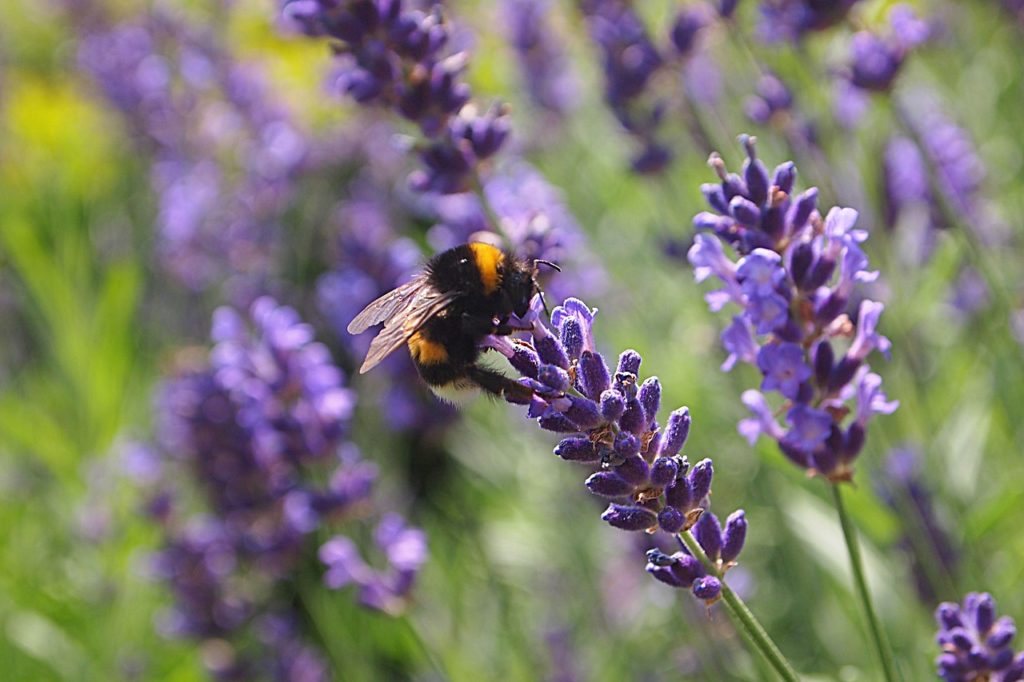Bees are important pollinators for plants not only in our home gardens, but in productive agricultural fields and natural environments around the world. If you’ve heard the phrase, ‘Save the Bees!’ at some point, it’s because some bee populations are currently on the decline from threats such as parasites, diseases, habitat loss, invasive species, and climate change.
Pesticides, in particular, can negatively impact bumblebee behavior, reproduction, and colony success. The most frequently used group of pesticides are called neonicotinoids, and due to their known connection to declining butterfly, bee, mayfly, and other insect populations, have been suspended from use on flowering bee-attractive crops by the European Union. Some countries, like Germany, France, and Italy, have placed bans on use of these chemicals throughout the years due to studies that have identified the detrimental effects.
Bee survival is controlled by a large number of factors, but queen bees in particular play an important role in determining the success of bee populations because they are responsible for initiating a colony. They are called “founding queens.” Queen bees can be exposed to pesticides applied to flowering plants in the early spring while foraging for nectar after hibernation. Recognizing how these queen bees are affected by exposure to pesticides is critical for mitigation of this important problem.
To better understand the impact of pesticides on founding queens and their ability to make a colony, researchers at the University of London and the University of Guelph studied bumblebee B. terrestris queens both in the field and in the laboratory. Observations in a nearby garden (i.e. “the field”) were made to understand how the bees responded to plants pre-treated with a neonicotinoid pesticide, clothianidin, an ingredient in the popular Modesto seed treatment. Back in the lab, eight bee treatment groups were created. These eight groups were split evenly, where four groups hibernated for 6 weeks, and four hibernated for 12 weeks. From the cluster that hibernated for 6 weeks, two groups were treated with a neonicotinoid pesticide called thiamethoxam, and the other two were left untreated.
From these two smaller groups, one of each was exposed to the parasite C. bombi. The process was repeated for the 12- week hibernation group. In the experiment, designated queen bee groups were first exposed to C. bombi, hibernated for their set amount of time, and then exposed to pesticides. These group subsets were created to understand how the bees fared when exposed to multiple environmental stressors, and control groups were added to serve as a comparisons to recognize how the bees would normally behave without the stressor.
Results showed that queens were not deterred from the plants treated with neonicotinoid pesticides (Modesto seed treatment with active pesticide clothianidin) out in the field, which provided justification for controlled laboratory experiments on pesticide effects. In the lab, detrimental effects of pesticide exposure were observed. Queen bees exposed to C. bombi resulted in a higher amount of weight loss during hibernation, and those that weighed less at the start of hibernation were found less likely to survive. Parasites did not impact any other traits measured. The queen bees that hibernated for the 6-week duration contained a smaller number of queens capable of laying eggs compared to the 12-week hibernation group. After hibernation, queens exposed to thiamethoxam laid eggs earlier than unexposed queens. Overall, colony initiation declined by 26% after exposure to neonicotinoid pesticide, which revealed an elevated risk of population extinction due to pesticide exposure.
This study reveals the detrimental effects of the neonicotinoid group of pesticides on queen bee colony initiation and development. The authors suggest that any policy decisions related to the neonicotinoid group of pesticides consider the list of species significantly impacted by exposure and the appropriate method and timing of application with respect to these organisms.
Before applying pesticides to your home lawn and flowers, consider protecting the bees, butterflies, and other organisms that beautify your yard, and perhaps seek out an alternative to these harmful chemicals.


